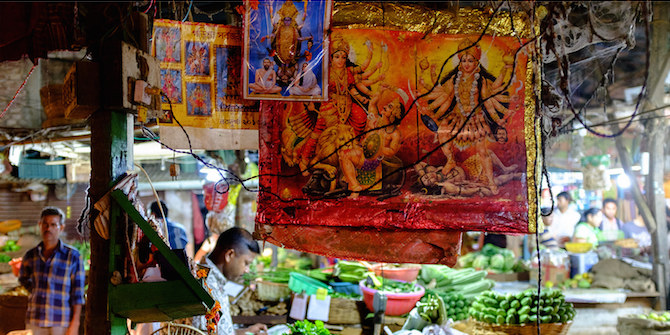There are almost five million Indians living in the USA today, with a much smaller minority being Christian. Binu Varghese argues that the unique cultural, national, and religious history of Indian American Christianity creates an ideal liminal space to form an anti-colonial identity within the church.

“I propose to visit all the churches of the St. Thomas Christians, purge them of their heresies and errors, teach them the Catholic doctrine, destroy all the heretical books which they possessed, and in the end convoke a synod of all their priests. I would get them to promise obedience to the Church of Rome and to take an oath to receive the prelate whom His Holiness would send.”
– Alexis de Menezes in a letter to Fabio Biondi, titular patriarch of Jerusalem, written on December 19th, 1597
When Archbishop Alexis de Menezes was commissioned under Padroado to Catholicise India, he was under the impression that the peninsula had never encountered Christianity. Soon, the Catholic mission turned into a civilising mission enforcing a Roman Catholic belief system on the ‘other Christian’. Meanwhile, Indian Christianity embarked upon a decades-long resistance against hegemonic colonial Christianity, resulting in an indigenous and anti-colonial identity. As the world is witnessing a shift in world Christianity toward epistemologies from the south, this essay analyses Indian American* Christianity facing disavowals and erasure from American Christian consciousness. This essay foregrounds the history and memory of Indian American Christians, especially Nasrani Christians who migrated to the U.S. We look at how liminal and contested spaces become grounds for decolonial exchanges.
Among recent scholarships, Next Evangelicalism by Soon Cha Rah problematises the essential moorings of American Christianity bound in existentialism and triumphalism, wreaking a cultural morass, thwarting the emergence and existence of ethnic churches. While reading alongside Prema Kurien’s Ethnic Church Meets Megachurch, Rah’s questions can be legitimised in the context of Indian American Christians leaving Indian churches for white American evangelical spaces. Similarly, the significant challenges the Syrian Christian communities face in the U.S. are the de-ethnicisation of their liturgical, ritual, and ecclesiastical practices. The struggle to navigate spaces of race, religion, and tradition becomes increasingly difficult for Nasrani Christians, considering their unique anti-colonial past. Their liminal existence is a major contextual characteristic that raises questions about the identity, faith, and life of Nasrani Christians in America. Meanwhile, ethnic and white evangelical Christianity is in constant flux due to simultaneous disavowal and acceptance of minoritised faith identities. In colonial discourses, the coloniser exercised power and domination over the colonised. Such power narratives assume essential differences and the inferiority of the colonised to the coloniser. Colonial ambivalences exist when the coloniser wants the colonised to be remarkably like them but not identical. A sameness cannot be ideal since a structural difference is highly expected in ambivalent colonial discourses. Thus, a liminal space is created.
Poignantly, the liminal space for Nasrani Christians is a memorialised space of contestations against the colonial endeavors of Padroado, the Portuguese Catholic mission (1452). The civilising mission of the Padroado was carried out under the tutelage of Archbishop Alexis de Menezes. Menezes found the Chaldean faith among St. Thomas Christians an impediment to his colonial civilising mission. He was outraged at the ‘other’ Christians’ identity and existence. He was obliged to the teachings of the council of Trent and considered himself appointed to remove anti-Nestorianism among Indian Christians. His efforts of Romanising Thomas Christians can be viewed as causa et effectus of the colonial agenda of otherisation and orientalisation. Amid forced syncretism, colonisation, and otherisation, Nasrani Christians sustained a counter-hegemonic faith movement that culminated in the historic Coonan Cross Oath on January 3rd, 1653. In this context, liminal space is also a decolonial space empowered by the historical past in (trans)forming the present.
The discourse of heritage thus transcends our memory of the past and locates itself in a new spectrality of time and space. Nasrani diasporic identity is thus “in-beyond and capable enough to re-draw itself through signifying practices of counter-ritualistic memories, creative hermeneutical engagements, and interactions of hospitality and fraternity.” The history of anti-colonialism in the past speaks to the present-day dispositions of Indian American Christianity. Furthermore, we arrive at a subversive understanding of present-day realities of Indian American faith and life juxtaposing liminality and decoloniality, first as a decentralising narrative shifting power from white evangelical discourse to Eastern spiritual formation, and then as the formative spirit for a decolonial transformative framework of Indian American Christianity.
A counter-ritualistic and resistant agency exists in the liminal spaces between colonial matrices and the periphery. Liminality provides freedom for new ideas and sparks genuine communion. The cracks and fissures between ethnic Christianity and evangelical Christianity complement and push towards the edges and borders. In Gloria Anzaldua’s words, las rajaduras (the cracks) give constructive and new topographies and look at the world through a new lens. So how do we achieve agency for a group or community or ideological stance or form? There is a need or responsibility to think from within and from the “insurgent constructions, creations, practices, and subject-actors that, from the outside, the borders, edges, and cracks challenge and defy modernity/coloniality”. A praxis-oriented model consists of a contextualised and collective form of agency for Nasrani Christians. The church’s mission has to be perceived as well-being for the community and recognised by the community. Any act of alienation can be an act of lostness. Nasranis achieve the fuller and vaster realisation of the church’s core values by adapting to the local context. Connecting or juxtaposing the anti-colonial past of Nasrani Christianity, and Indian Americans’ lived-in religious life has unique impediments.
A narrowly focused decolonial praxis is, after all, exclusionary and overtly divisive. A fruitful decolonial praxis entails a liberative understanding of race, religion, and caste in the diaspora. For example, dismantling internal high caste sentiments, antiblackness in the diaspora, and the erasure of Dalit identity and consciousness. So, the liminal space of Nasrani Christians has to be decolonising and transformative in essence. Nasrani decolonial approach has to be a non-Eurocentric subjectivity to the insurgent spectrum of contestations, delinking, and dissensions in knowing, experiencing, and voicing.
* “Indian American” is used to refer to Indian Americans; Americans with Indian heritage and/or nationality





